Learn To Play Rock Guitar
Beginner rock guitar lessons for n00bs and rusty rockers
Notes On The Guitar - Sharp Notes
As we discussed in the last lesson for notes on the guitar, the natural notes are A, B, C, D, E , F and G. Once we have these down and spend some time memorizing where they are on the fingerboard, it's pretty easy to figure out which notes are either sharp or flat - also referred to as 'accidental' notes.
Another way to look at it: there are twelve notes on the guitar available to you in a scale - seven natural notes and five notes that fill the spaces between the natural notes. These are called accidental notes. Just for the purpose of completeness, all twelve notes are as follows:
A, A#, B, C, C#, D, D#, E, F, F#, G and G# (with sharp accidentals)
G, Gb, F, E, Eb, D, Db, C, B, Bb, A and Ab (with flat accidentals)
The way you determine whether a note is sharp or flat is simple: which way are you coming from? If you are going up in pitch in the scale, the accidental notes on the guitar are "sharp." If you are descending in the scale (going down in pitch), the notes are "flat."
Sharp Notes
The notes on the finger board between natural notes are called sharp notes when you are ascending in a scale.
E String (Sixth String)
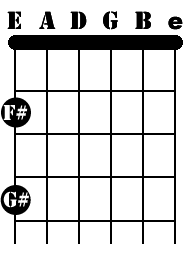
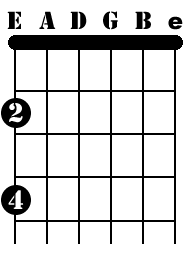
On the low E (sixth string), you recall we played the E note on the open string. The first note we play going up the guitar neck is F natural on the first fret. By moving up one more fret (to the second fret), we are now fingering the F# (F sharp) note. Use your middle finger for F#.
Slide one more fret up from the F# and we have the G note on the third fret. Up one more fret is the G# (G sharp) note. You can use your pinky finger to play the G# note.
A String (Fifth String)
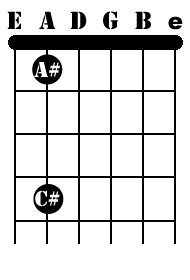
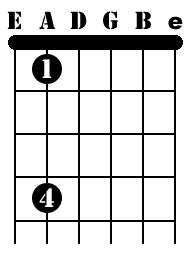
As we move up the fingerboard on the A string, the first fret gives us A# (A Sharp). Play this note using your index finger.
We saw the B and C natural notes on the second and third frets, respectively. Going to the fourth fret gives us C# (C Sharp).
D String (Fourth String)
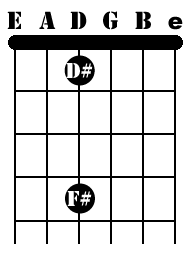
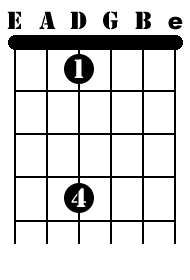
The D string is very similar to the A string. The first fret is D# (D Sharp), played with the index finger
We'll skip over E and F (second and third frets) natural notes on the guitar neck
The fourth fret yields an F# (F Sharp) note, which we can play using our pinky finger.
G String (Third Sting)
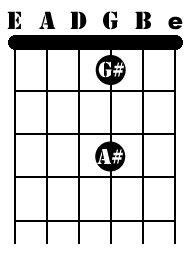
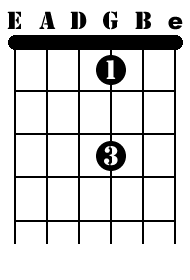
Again our first sharp note falls on the first fret. This is a G# note (G Sharp), played using your index finger.
The A# note (A Sharp) is located at the third fret; use your ring finger for this note. The fourth fret is the B natural note, which is the same as the second string, so just move there as you ascend the notes on the guitar.
B String (Second String)
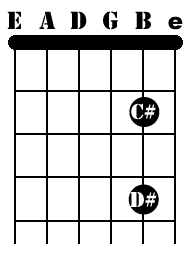
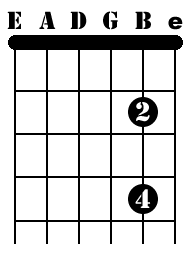
The first sharp note we encounter is C# (C Sharp) on the second fret of the B string. Play this note using your middle finger.
Move up the neck two frets to the fourth fret. This note is D# (D Sharp). You can use your pinky finger for this note.
e String (First String)
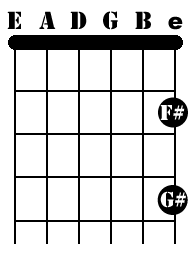
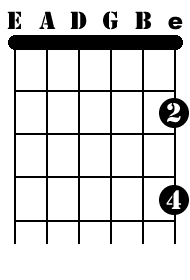
Finally, on the first string we repeat what we saw on the sixth string. The F# note is at the second fret, and the G# is at the fourth fret.
You can practice playing all the sharp notes using a mode from the minor pentatonic scale (the second mode). Don't worry if that doesn't mean anything to you yet. Just follow along with the diagrams below. As you ascend the sharp notes on the guitar, this pattern will give you each one within the first five frets, which I usually refer to as the open position.
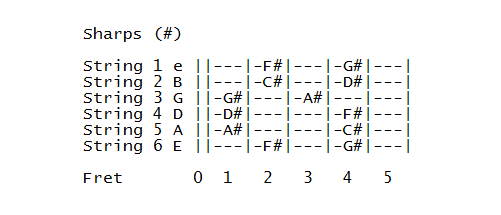
You can use the tab below to play each of the open position sharp notes on the guitar.

With the sharp notes covered, it's time to look at the flat notes on the guitar...
|
|

